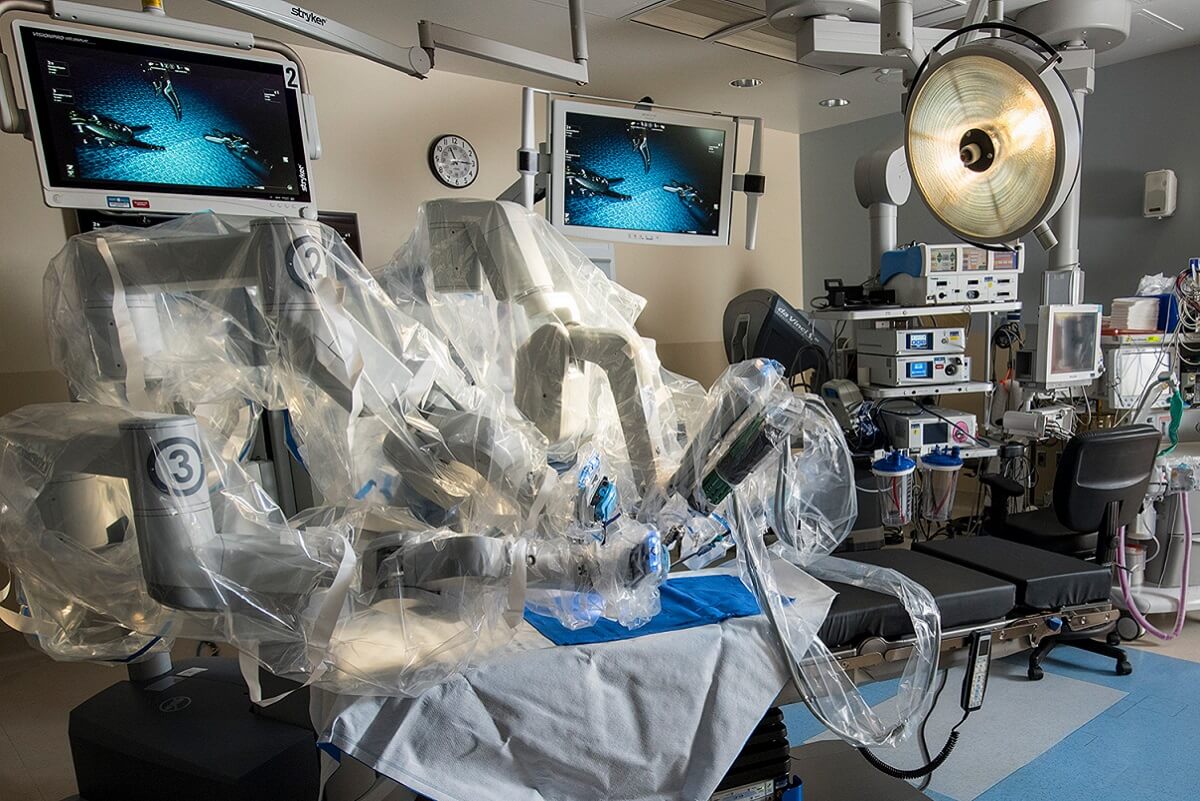Robot Surgery: Advancements in Surgeon Technology
November 16, 2022
Categories: Medical Innovations, Oncology
Surgeons perform state-of-the-art robotic operations to cure patients of complex cancers
Imagine you are lying on an operating table under general anesthesia. Health care professionals prepare for an operation to remove a cancer from your abdomen. The surgeon makes four tiny incisions and inserts small tubes. The nurse steers a four-armed robot to the edge of the operating table. The robot looks like the Tesla version of something that would stock inventory at a store.
Next, the surgical team connects the robot arms to the tubes and inserts the instruments and a camera. The lights go out in the room. The surgeon sits down in the corner, 15 feet away from the table where you are sleeping.
The surgeon presses her forehead against a three-dimensional viewfinder and inserts her thumb and index finger of each hand into the robotic console’s arm controls. Then she drives the camera inside your abdomen to the target area where the cancer is. She begins removing it from your body.
While this might sound like something from a science fiction series, it's happening every day at Saint Alphonsus Regional Medical Center in Boise. Surgeons perform state-of-the-art robotic operations to cure patients of complex cancers of the prostate, uterus, colon, stomach, esophagus and lung. Saint Alphonsus is the only hospital in Idaho that performs robotic lung resections and robotic esophagectomy for cancers.
Surgery is traumatic. It causes pain, bleeding, swelling, and requires a recovery period to get back to your normal life. For the last 50 years, medical science has been searching for ways to remove or repair cancerous, infected, or dysfunctional organs with less invasive surgical techniques. Some of these innovations have fallen by the wayside and some have proven useful. Others have changed the way we practice surgery.
I trained in surgical residency at a time when laparoscopy (operating through small incisions with a lighted telescope and narrow, straight, rigid instruments) was becoming widely adopted as the preferred surgical approach for minor surgeries like appendicitis and gallbladder problems. It took time to refine the techniques and many years to overcome the negative view of senior surgeon naysayers. Eventually, the extensive benefits of laparoscopic surgery have proven superior to traditional “open” abdominal surgery with large incisions. Patients experienced smaller incisions, fewer wound complications, shorter hospital stays, and faster recoveries.
Today, robotic assisted surgery is having a similar impact on surgical care.
Robotic surgical technology improves the surgeon’s ability to see with three-dimensional, high-definition viewing. This allows for depth perception and surgeon control of the camera. The surgeon also controls three working arms instead of two in laparoscopy. These arms control instruments that provide 540-degrees of rotational, tremor-filtered movement. The surgeon works in a comfortable seated position at a console. This technology drastically increases surgeon confidence and the ability to operate in very small spaces. This means I can cut, cauterize, dissect, and suture with greater precision and accuracy than with either laparoscopic or open surgical techniques. I also avoid developing the unavoidable element of fatigue associated with long, complex, laparoscopic or open surgeries.
Our patients are experiencing the dramatic benefits of robotic surgery. They have less pain, shorter hospital stays for major operations, less blood loss, and fewer conversions to open operations when compared to laparoscopic procedures.
Dr. Christopher Reising, MD, FACS is a general surgeon at Saint Alphonsus. He has more than 20 years of experience, focusing on robotics and minimally invasive surgery.
For additional information about Robotic Surgery, click here.

